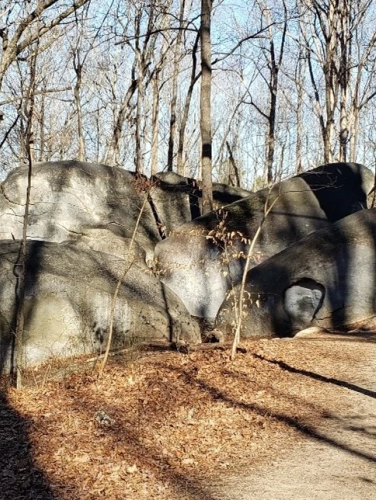
Big Rock Rock Shelter
(ca. 5000 B.C.E.)
Mecklenburg County’s earliest inhabitants likely used the Big Rock Rock Shelter as a space for habitation, gatherings, and observation.
6500 Elmstone Dr #6930, Charlotte, NC 28277
The Big Rock Rock Shelter is one of many plutons or bodies of intrusive igneous rock that appear in the Piedmont plateau of the two Carolinas. Located on a northwestward sloping hillside near a tributary of Four Mile Creek in southern Mecklenburg County, the Big Rock Rock Shelter consists of a cluster of sizeable, randomly distributed granite boulders that have been exposed by weathering over the eons. Although such geological formations are widely dispersed throughout Mecklenburg County, the Big Rock Rock Shelter is locally significant because it contains the largest known exposed boulders in Mecklenburg County. As it has experienced minimal ground disturbance, the Big Rock Rock Shelter is an especially important archeological resource.
Property Quick Links
The Big Rock Rock Shelter and its immediate surroundings contain Native American habitation debris from as early as 7000 years ago, as well as prehistoric and historic artifacts from more recent periods. The existence of a multilayered or stratified archeological deposit is a rare discovery in this region. The area’s combination of natural shelter, vantage, and various upland resources (including a nearby perennial spring as a convenient water source) attracted inhabitants to the area for several thousand years, as evidenced by such archeological discoveries in and around the formation as potsherds, sharp-edged waste materials, various stone and bone tools, and animal bone, shell, and plant remains. In 1964, investigators discovered and identified a two-sided stone tool or biface as a Morrow Mountain projectile point (ca. 5500-4500 B.C.E.).
Despite the absence of definitive physical evidence, it is reasonable to assume that the Big Rock Rock Shelter site served as a campsite, rendezvous point, and observation post for the first inhabitants of what is now Mecklenburg County. They were Paleo or Ancient Native Americans whose forebears had migrated from Asia across a Bering Strait made dry by advancing glaciers some 40,000 years ago. Those early nomads reached the Carolina Piedmont about 12,000 years ago, wandering over the Blue Ridge and Smoky Mountains in pursuit of big game. Living in highly mobile and lightly equipped groups, the Paleo Native Americans ambushed their prey – principally now extinct giant mammals – by thrusting spears into their flanks at close range. Native American materials recovered from the Big Rock Rock Shelter site mostly date from three principal periods: Early Woodland (c. 600-100 B.C.E.), Mississippian (c. 1300-1450 C.E.), and Late Woodland (c. 1650-1850 C.E.).

